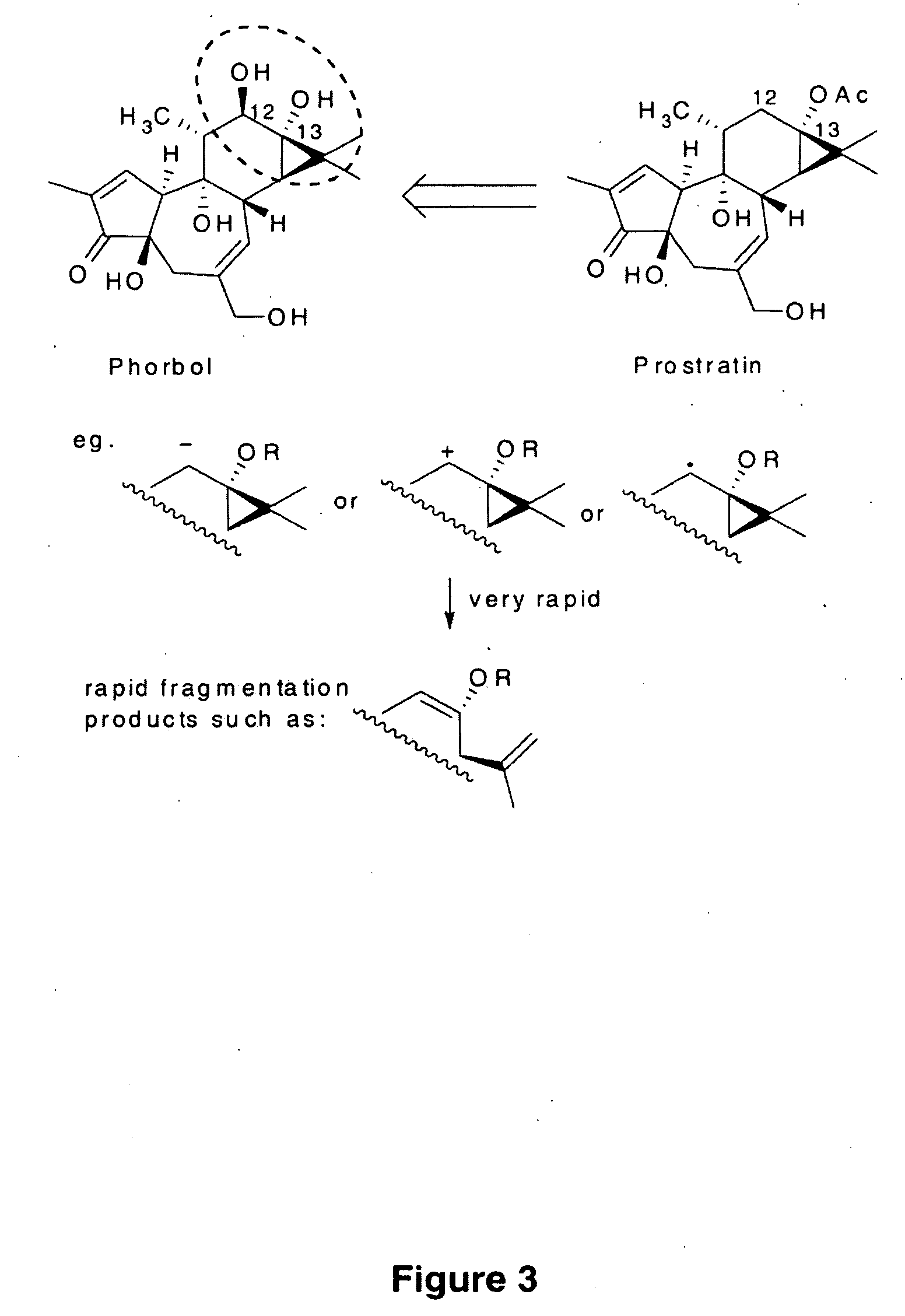Process to Produce Prostratin and Structural or Functional Analogs Thereof
a technology of structural or functional analogs and prostratin, which is applied in the preparation of carbonyl compounds, organic chemistry, chemistry apparatus and processes, etc., can solve the problems of long treatment time, low isolation yield, and the effect of viral rebound at a later stag
- Summary
- Abstract
- Description
- Claims
- Application Information
AI Technical Summary
Benefits of technology
Problems solved by technology
Method used
Image
Examples
example 1
Generation of Enol Acetate
[0137]
[0138]Phorbol-12-acetate-C-20 trityl ether, S1, (300 mg, 462 μmol) in freshly distilled pyridine (4.6 mL) was stirred under argon and mesyl chloride (55 μL, 1.5 eq) was added. The reaction mixture was heated to 60° C. for 1.5 hr, at which time complete consumption of the starting material was noted by TLC. The mixture was allowed to cool, diluted with ethyl acetate (100 mL), and washed with brine (2×20 mL). The organic phase was separated, dried over Na2SO4, filtered to remove the drying agent and then concentrated in vacuo. The residue was subjected to flash chromatography (40-80% EtOAc / pentane, ˜25 g silica, ID 25 mm) to give the product S2 as an off-white foam (220 mg, 76%).
[0139]TLC Rf=0.76 (40% EtOAc / Pentane), one black spot in p-anisaldehyde (visible under UV lamp);
[0140][α]D23.5=+61.3° (c 0.61, CHCl3)
[0141]1H NMR (500 MHz, CDCl3): δ 7.56 (br s, 1H, C1-H), 7.42-7.20 (m, 15H, Ar—H), 5.66 (br s, 1H, C7-H), 5.04 (s, 1H), 5.00 (s, 1H), 4.96 (s, 1H),...
example 2
Production of the Intermediate Acetoxypyrazoline
[0145]
[0146]The enolacetate S2 (92 mg, 146 μmol) in methanol (1.5 mL) was stirred while K2CO3 (30 mg, 1.5 eq.) was added in a single portion. After 30 minutes of vigorous stirring consumption of the starting material and complete conversion to ketone S3 was noted. Acetic acid (33 μL, 4 eq) and hydrazine hydrate (11 μL, 1.5 eq.) were added. The reaction was allowed to stir for an additional 1 hour and monitored by TLC (100% EtOAc). Generation of the hydrazone intermediate S4 is indicated by the formation of a large, green baseline spot (PA Stain). Once the formation of the hydrazone is complete, basic alumina (500 mg) and EtOAc (15 mL) were added to the reaction mixture. The mixture was filtered through a pad of CELITE® and concentrated. The off-white hydrazone solid was redissolved in toluene (2.0 mL) and DIPEA (200 μL) in a sealed tube. The solution was degassed (freeze-pump-thaw, 3 times) and flushed with argon. The reaction vessel w...
example 3
Removal of Trityl Protecting Group
[0152]
[0153]A solution of S6 (5.0 mg, 7.6 μmol) in methanol (750 μL) was stirred at room temperature under air. HClO4 (70% in H2O, 7.5 μL) was added, and the reaction was allowed to stir for 20 min. The mixture was neutralized by the addition of NaHCO3 (solid, 20 mg) and stirred for 10 minutes. The crude mixture was filtered through CELITE® and the volatiles were removed under reduced pressure. The residue was subjected to flash chromatography (100% ethyl acetate, ID 8 mm, ˜1 g silica) to give S7 as a white solid (2.9 mg, 90%). Physical measurement showed:
[0154]TLC Rf=0.08 (100% EtOAc), one black spot in p-anisaldehyde (visible under UV lamp); [α]D23.5=+45.6° (c 0.34, CHCl3)
[0155]1H NMR (500 MHz, CDCl3): δ 7.51 (s, 1H, C1-H), 5.50 (d, J=3.9 Hz, 1H, C7-H), 4.04 (d, J=12.8 Hz, 1H, C20-H), 4.02 (d, J=13.1 Hz, 1H, C20-H), 3.25 (dd, J=4.9, 11.7 Hz. 1H, C8-H), 3.03 (br s, 1H, C10-H), 2.55-2.49 (m, 2H, C11-H and C5-H), 2.42 (d, J=19.2 Hz, 1H, C5-H), 2.34 (...
PUM
| Property | Measurement | Unit |
|---|---|---|
| temperature | aaaaa | aaaaa |
| wavelength | aaaaa | aaaaa |
| wavelength | aaaaa | aaaaa |
Abstract
Description
Claims
Application Information
 Login to View More
Login to View More - R&D
- Intellectual Property
- Life Sciences
- Materials
- Tech Scout
- Unparalleled Data Quality
- Higher Quality Content
- 60% Fewer Hallucinations
Browse by: Latest US Patents, China's latest patents, Technical Efficacy Thesaurus, Application Domain, Technology Topic, Popular Technical Reports.
© 2025 PatSnap. All rights reserved.Legal|Privacy policy|Modern Slavery Act Transparency Statement|Sitemap|About US| Contact US: help@patsnap.com



